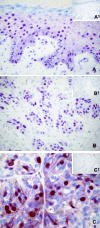Expression of survivin protein in pterygium and relationship with oxidative DNA damage
- PMID: 18266976
- PMCID: PMC4514115
- DOI: 10.1111/j.1582-4934.2008.00256.x
Expression of survivin protein in pterygium and relationship with oxidative DNA damage
Erratum in
- J Cell Mol Med. 2009 Jan;13(1):207-9
Abstract
Ultraviolet radiation is known to cause oxidative DNA damage and is thought to be a major factor implicated in the pathogenesis of pterygium. Among all the photo-oxidative DNA products, the 8-hydroxydeoxyguanosine (8-OHdG) is regarded a sensitive and stable biomarker for evaluating the degree of DNA damage. The protein p53 is a major cell stress regulator that acts to integrate signals from a wide range of cellular stresses. UV radiation has a carcinogenic effect resulting in DNA damaged cells with loss of normal growth control. This assumption is supported by the association between UV-B exposure and activation of survivin, a member of the inhibitor of apoptosis protein family (IAP), highly up-regulated in almost all types of human malignancy. In this study we demonstrate, for the first time in pterygium, the immunohistochemical presence of survivin, and investigate the correlation between survivin, p53 and 8-OHdG. Our results demonstrate that oxidative stress could lead to a significant activation of survivin expression, suggesting that this might be an important event in the development of pterygium, inducing and supporting a hyperproliferative condition. Survivin expression in pterygium would counteract UV-B-induced apoptosis and would cooperate with loss of p53. The co-operation between survivin and functional loss of p53 might provide a general mechanism for aberrant inhibition of apoptosis that could be responsible for the development of pterygium and its possible progression to neoplasia.
Figures



Similar articles
-
Oxidative stress in pterygium: relationship between p53 and 8-hydroxydeoxyguanosine.Mol Vis. 2006 Sep 30;12:1136-42. Mol Vis. 2006. PMID: 17093398
-
Increased oxidative DNA damage, 8-hydroxydeoxy- guanosine, in human pterygium.Eye (Lond). 2006 Jul;20(7):826-31. doi: 10.1038/sj.eye.6702064. Epub 2005 Aug 19. Eye (Lond). 2006. PMID: 16113633
-
Expression of p53 protein in pterygium.Eur J Ophthalmol. 1998 Jul-Sep;8(3):157-61. doi: 10.1177/112067219800800307. Eur J Ophthalmol. 1998. PMID: 9793769
-
Risk factors for pterygium: Latest research progress on major pathogenesis.Exp Eye Res. 2024 Jun;243:109900. doi: 10.1016/j.exer.2024.109900. Epub 2024 Apr 16. Exp Eye Res. 2024. PMID: 38636803 Review.
-
P53 expression in altered limbal basal cells of pingueculae, pterygia, and limbal tumors.Curr Eye Res. 1997 Dec;16(12):1179-92. doi: 10.1076/ceyr.16.12.1179.5036. Curr Eye Res. 1997. PMID: 9426949 Review.
Cited by
-
Survivin and p53 expression in primary and recurrent pterygium in Chinese patients.Int J Ophthalmol. 2011;4(4):388-92. doi: 10.3980/j.issn.2222-3959.2011.04.13. Epub 2011 Aug 18. Int J Ophthalmol. 2011. PMID: 22553687 Free PMC article.
-
Peroxiredoxin I and II in human eyes: cellular distribution and association with pterygium and DNA damage.J Histochem Cytochem. 2014 Jan;62(1):85-96. doi: 10.1369/0022155413508409. Epub 2013 Oct 23. J Histochem Cytochem. 2014. PMID: 24152995 Free PMC article.
-
Human papillomavirus infection and ocular surface disease (Review).Int J Oncol. 2019 May;54(5):1503-1510. doi: 10.3892/ijo.2019.4755. Epub 2019 Mar 19. Int J Oncol. 2019. PMID: 30896784 Free PMC article. Review.
-
Aberrant expression of genes and proteins in pterygium and their implications in the pathogenesis.Int J Ophthalmol. 2017 Jun 18;10(6):973-981. doi: 10.18240/ijo.2017.06.22. eCollection 2017. Int J Ophthalmol. 2017. PMID: 28730091 Free PMC article. Review.
-
Induction of endothelial RAGE expression in pterygium.Mol Vis. 2014 Dec 23;20:1740-8. eCollection 2014. Mol Vis. 2014. PMID: 25593504 Free PMC article.
References
-
- Saw SM, Tan D. Pterygium: prevalence, demography and risk factors. Ophthalmic Epidemiol. 1999;6:219–28. - PubMed
-
- Coroneo MT, Di Girolamo N, Wakefield D. The pathogenesis of pterygia. Curr Opin Ophthalmol. 1999;10:282–8. - PubMed
-
- Detorakis ET, Drakonaki EE, Spandidos DA. Molecular genetic alterations and viral presence in ophthalmic pterygium. Int J Mol Med. 2000;6:35–41. - PubMed
-
- Sakoonwatanyoo P, Tan DT, Smith DR. Expression of p63 in pterygium and normal conjunctiva. Cornea. 2004;23:67–70. - PubMed
Publication types
MeSH terms
Substances
LinkOut - more resources
Full Text Sources
Research Materials
Miscellaneous

